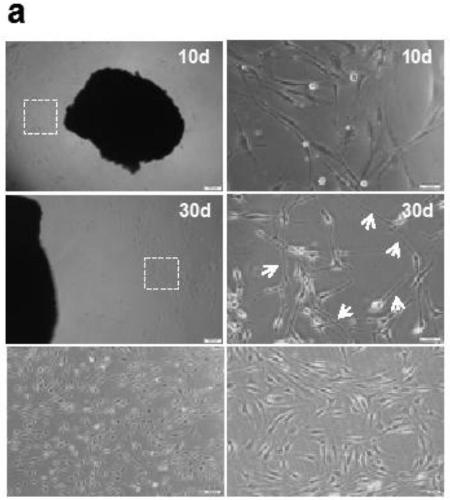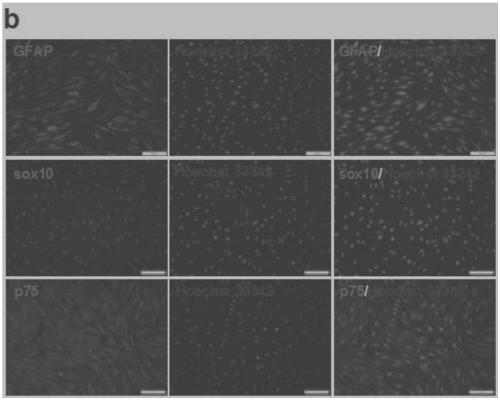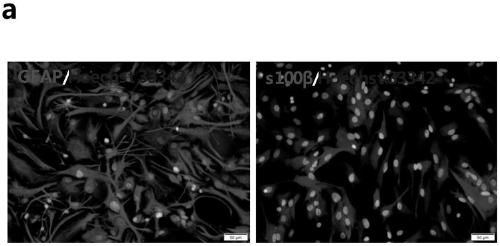Application of miR containing 5'- terminal specific seed base sequence, improved Schwann cell and applications thereof
A Schwann cell and base sequence technology, applied in the field of improved Schwann cells, can solve the problem of inability to stagger fusion and so on
- Summary
- Abstract
- Description
- Claims
- Application Information
AI Technical Summary
Problems solved by technology
Method used
Image
Examples
Embodiment 1
[0050] Isolation, culture and identification of rat Schwann cells:
[0051] The sciatic nerve of adult female Wistar rats (200-250 g) was taken, and the muscle tissue, fat, blood vessels and epineurium were peeled off with micro forceps and ophthalmic scissors under a microscope in a sterile operating table. After obtaining the white nerve fibers, soak them in sterile PBS (phosphate buffer solution), and cut them into tissue pieces with a length of about 2 mm by using an ophthalmologist. Discard the liquid, add 0.1% type I collagenase and digest in a cell incubator at a constant temperature of 37°C for 25 minutes. Discard the type I collagenase and wash the residual enzyme solution with sterile PBS to terminate the digestion reaction. Use micro tweezers to remove the tissue block and place it in a clean cell culture dish to adhere to the bottom of the dish, add a small amount of SCM (Schwann cell culture medium: DMEM / F12+10% fetal bovine serum+fibroblast growth factor bFGF+ne...
Embodiment 2
[0055] Example 2 Comparison of miR-124-3P content in Schwann cells, astrocytes and normal bone marrow cells:
[0056] Isolation and culture of rat astrocytes:
[0057] The brains of suckling rats were taken out from 1-3 days old rats, and the cerebral cortex was peeled off under a microscope under a sterile operating table. Soak in sterile DMEM. Break the cerebral cortex tissue into a uniform particle-free suspension by pipetting with a 5ml pipette tip. Collect the tissue fluid in a sterile centrifuge tube and discard the supernatant to collect the precipitate. Tissues were digested with 0.05% trypsin and DNase (Deoxyribonuclease I, Worthington) at 37°C for 25 minutes. Use a sterile filter 40μm-sterile EASYstrainer after terminating digestion TM (Greiner bio-one) to obtain a single cell suspension. After centrifugation, the precipitate was collected and washed three times with PBS. ASM for cells (astrocyte culture medium: DMEM / F12 + 10% fetal bovine serum + fibroblast gr...
Embodiment 3
[0064] 2Taking lentivirus as an example: lentivirus transfection of Schwann cells to obtain improved Schwann cells
[0065] 2.1 Construction of improved Schwann cells (Schwann cells with high expression of miR-124-3P)
[0066] 2.1.1 Entrust Shanghai Jikai Gene Chemical Technology Co., Ltd. to construct lentivirus GV309 with titer and stable expression of miR-124-3P, and obtain miR-124-3P lentivirus vector. The viral titer of the obtained miR-124-3P lentiviral vector was 6E+8, and the expression level of miR-124-3P was about 4 times that before transfection.
[0067] 2.1.2 Determine the optimal MOI value (multiplicity of infection).
[0068] The miR-124-3P lentiviral vector was used to infect Schwann cells with gradient MOI values of 1, 10, 25, 50, and 75, respectively. After 48 hours, the infection efficiency exceeded 80% and the MOI value with the least cytotoxicity (MOI=50) was the best. The optimal MOI value is used for subsequent experiments.
[0069] 2.1.3 Determine ...
PUM
| Property | Measurement | Unit |
|---|---|---|
| length | aaaaa | aaaaa |
Abstract
Description
Claims
Application Information
 Login to View More
Login to View More - R&D
- Intellectual Property
- Life Sciences
- Materials
- Tech Scout
- Unparalleled Data Quality
- Higher Quality Content
- 60% Fewer Hallucinations
Browse by: Latest US Patents, China's latest patents, Technical Efficacy Thesaurus, Application Domain, Technology Topic, Popular Technical Reports.
© 2025 PatSnap. All rights reserved.Legal|Privacy policy|Modern Slavery Act Transparency Statement|Sitemap|About US| Contact US: help@patsnap.com



